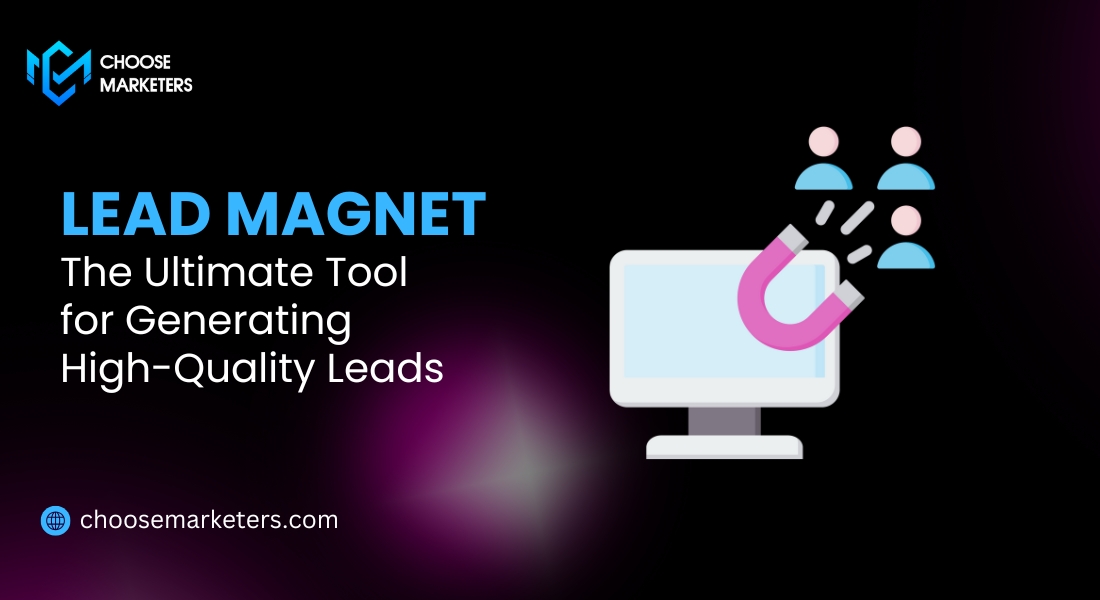

Lead Magnet: The Ultimate Tool for Generating High-Quality Leads
Lead magnets are a crucial component of any successful marketing strategy, especially when it comes to growing an engaged and relevant email list. But what exactly it is , and how can you use it to capture high-quality leads for your business? In this comprehensive guide, we will explore everything from the definition to best practices for creating and promoting them. We will also dive into specific strategies to ensure that your lead magnet drives conversions and brings tangible results.
Lead Magnet
It is a marketing tool used to attract potential customers by offering something valuable—such as a free resource, guide, or trial—in exchange for their contact information. It serves as a bridge between your business and potential leads, helping to build relationships and guide prospects through the sales funnel. Lead magnets are commonly used in digital marketing to generate qualified leads, build email lists, and nurture long-term engagement with prospects.
Why Lead Magnets Are Critical for Generating Leads
The importance of lead magnets cannot be overstated, particularly for businesses seeking to attract potential customers and nurture them into loyal clients. In a world filled with endless distractions, capturing a lead’s contact information is the first step toward building a lasting relationship. It helps bridge the gap between casual interest and actual engagement.
Lead magnets offer multiple benefits for businesses. First, they attract qualified leads who are genuinely interested in what you offer. By providing something valuable in exchange for contact information, you can ensure that your leads are more likely to engage with your future marketing efforts. Additionally, offering businesses to build trust and credibility by demonstrating expertise. Lastly, a well-executed lead strategy can significantly increase conversions by nurturing potential leads until they are ready to make a purchase.
Types of Lead Magnets That Convert Best

Choosing the right type is critical for success. Different formats work better depending on your audience and the nature of your business. E-books, for example, are highly effective for businesses offering knowledge-based products, while free trials or discounts work well for e-commerce stores.
Common types of lead magnets include:
E-books: These are ideal for providing in-depth insights into a particular subject relevant to your audience.
Webinars: A great way to establish authority while engaging with your leads in real-time.
Checklists: These work well for solving specific problems quickly and efficiently.
Exclusive Discounts or Coupons: Perfect for e-commerce businesses looking to convert browsers into buyers.
Free Trials: SaaS businesses can leverage free trials to give users a taste of the product before committing to a purchase.
Whatever form your takes, the most important factor is that it provides immediate value and solves a specific problem for your audience.
Features of an Effective Lead Magnet
For your lead magnet to be effective, it needs to offer real value to your audience. The days of generic, low-value offers are over—people expect something relevant and helpful in exchange for their contact information. So, what makes it successful?
First, it must be relevant to your target audience’s needs and desires. If it doesn’t resonate with the pain points of your leads, they are unlikely to engage. Additionally, the content needs to offer immediate value. Whether it’s an actionable tip, a tool, or a piece of valuable insight, they must provide instant gratification. Simplicity is also key. Overcomplicating your offer or making it difficult to consume will deter potential leads. Lastly, an effective lead magnet must solve a specific problem for your audience and be highly actionable.
How to Choose the Right Lead Magnet for Your Audience
Not all incentives for attracting potential clients are equally effective, and what works for one company may not necessarily suit another. The key to choosing the right strategy lies in understanding your audience. What challenges do they face? What issues are they struggling with? A compelling offer directly tackles these concerns and provides a solution.
For example, if you run a marketing agency, your audience might be looking for ways to generate leads in the form of a free webinar on “Top Strategies for Lead Generation” would be a perfect fit. On the other hand, an e-commerce business might find more success with a discount coupon or a free shipping offer.
It’s also important to align them with, where your prospects are in the buyer’s journey. Those in the awareness stage might appreciate an educational e-book, while those further along in the funnel could benefit from a free trial or a product demo.
Steps to Create a High-Converting Lead Magnet
Once you have identified the right lead for your audience, it’s time to create and promote it. The process begins by identifying your target audience and understanding their needs. Next, you must choose a content format that fits these needs—whether it’s a checklist, e-book, or webinar. The design of your lead magnet is equally important. A visually appealing and professional-looking design will increase perceived value and encourage downloads.
Once it is ready, you need to create a dedicated landing page where users can opt-in to receive it. This page should be simple, with clear calls to action and minimal distractions. The next step is to promote your work across various channels, including your website, social media, email campaigns, and paid ads.
Lead Magnet Best Practices
To maximize the effectiveness of your lead magnet, it’s essential to follow some best practices. One of the most important is optimizing the opt-in process. Make sure that your sign-up form asks for only essential information, such as name and email address. The more fields you add, the fewer people will complete the form.
Another critical practice is using a strong call to action (CTA). Your CTA should clearly explain the benefit of downloading and create urgency, encouraging visitors to act immediately. Don’t forget to ensure that your opt-in form and CTA are mobile-friendly, as a significant portion of web traffic comes from mobile devices.
Lastly, consider using exit-intent pop-ups to capture leads who are about to leave your site. This tactic offers a last-minute chance to convert visitors who might otherwise leave without taking action.
How to Promote Your Lead Magnet Effectively
Creating a lead magnet offer is only half the battle—you also need to make sure it reaches your target audience. Start by promoting it through content marketing strategies such as blog posts or videos that link to your offer. Additionally, share it across all your social media channels. A well-timed post on platforms like Facebook or LinkedIn can drive significant traffic.
For more immediate results, consider investing in paid advertising through platforms like Google Ads or Facebook Ads. These platforms allow you to target specific audiences and drive traffic to your landing page.
Analyzing Lead Magnet Performance
Once your lead magnet is live, you need to track its performance to ensure it’s delivering results. Key metrics to monitor include the conversion rate of your landing page, the engagement rate of those who download the magnet, and the cost per lead if you’re using paid ads to promote it.
By analyzing these metrics, you can refine your lead magnet strategy and make adjustments to improve performance over time.
Common Mistakes to Avoid with Lead Magnets
One of the biggest mistakes businesses make is offering content that’s too vague or doesn’t provide enough value. It should offer something concrete and actionable—something that leaves the recipient feeling like they’ve gained real insight or a useful tool.
Another common mistake is overcomplicating the opt-in process. Asking for too much information can scare away potential leads. Stick to the essentials: name and email address are often enough. Finally, make sure that your lead magnet aligns with your audience’s needs. Offering somthing that doesn’t resonate with your audience can lead to low conversion rates and wasted effort.
How Lead Magnets Fit Into the Sales Funnel
Lead magnets are typically placed at the top of the sales funnel, where they help capture the interest of potential leads and move them into the consideration phase. Once someone has opted in, the lead magnet should be followed by a nurturing campaign that continues to provide value and keeps your brand top of mind.
Over time, these leads can be nurtured into making a purchase, especially when combined with follow-up email sequences that provide additional value and information.
Using Lead Magnets in Different Industries
The versatility of lead magnets makes them useful in a wide range of industries. In e-commerce, a discount code or free shipping offer is a popular choice, while SaaS companies often use free trials or demos to convert leads. Professional services might offer consultations or in-depth whitepapers.
By tailoring the lead magnet to your industry and audience, you can increase the likelihood of capturing qualified leads and ultimately driving sales.
Real-World Examples of Successful Lead Magnets
Many companies have seen tremendous success using lead magnets to grow their email lists and increase conversions. For example, a marketing agency offering a free SEO audit can position itself as an expert while providing value to potential clients. Similarly, an online retailer offering a limited-time discount in exchange for an email opt-in can boost sales while building its customer base.
Connecting Lead Magnets to Email Marketing
A lead magnet is integral to email marketing as it provides valuable content or incentives in exchange for a visitor’s email address. This exchange helps businesses build a targeted email list, which is crucial for nurturing leads. By leveraging email marketing, businesses can follow up with personalized messages, promote their offerings, and ultimately drive conversions.
Lead magnets are a powerful tool for any business looking to grow its email list and generate high-quality leads. By understanding your audience, creating a compelling offer, and promoting it effectively, you can maximize the impact of your lead magnet strategy. Whether you’re a small business or a large enterprise, lead magnets can help you build trust, engage your audience, and drive conversions.

